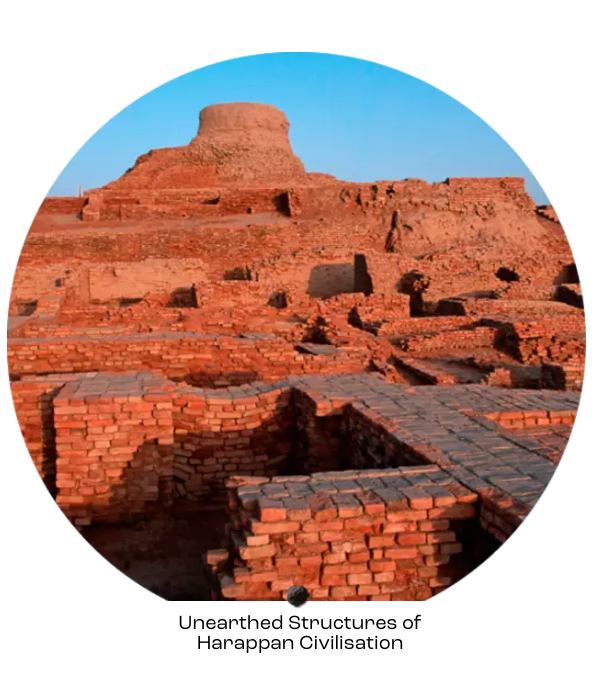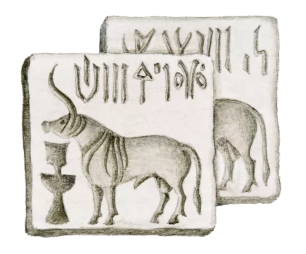Content
[6] Upinder Singh, A History of Ancient and Early Medieval India: From the Stone Age to the 12th
Century, Pearson, New Delhi,
[7] W. A. Fairservis, The origin, character, and decline of an early civilization. American
Museum Novitates 2302, 1967, 1–48.
[8] Sir John Marshal, Mohenjo-daro and Indus Civilization (Being An Official Account of
Archaeological Excavations at Mohenjo-daro carried out by the Government of India between the
year 1922 and 1927) Volume I, Arthur Probsthain, London, 1931, p. vi
[9] J. M. Kenoyer, “Craft traditions of the Indus civilization and their legacy in modern
Pakistan”, Lahore Museum Bulletin, Vol. 9, 1996, pp. 1–8; V. N. Prabhakar, “Decorated carnelian
beads from the Indus civilization site of Dholavira (Great Rann of Kachchha, Gujarat)”, In D.
Frenez, G. M. Jamison, R. Law, M. Vidale, and R. Meadow, R. (eds.), Walking with the Unicorn:
Social Organization and Material Culture in Ancient South Asia, Archaeopress, Oxford, 2018, pp.
477–489; M. Vidale, “Aspects of palace life at Mohenjo-Daro”, South Asian Studies, Vol. 26,
2010, pp. 59–76; M. Vidale, “A “priest king” at Shahr-i Sokhta?”, Archaeological Research in
Asia, Vol. 15, 2018, 110–115 and M. Vidale, “Heterarchic powers in the ancient Indus cities”,
Journal of Asian Civilizations, Vol. 41, No. 2, 2018, pp. 1–46.
[10] W. A. Fairservis, The Harappan civilization: New evidence and more theory. American Museum
Novitates 2055, 1961, pp. 1–35 and W .A. Fairservis, The origin, character, and decline of an
early civilization. American Museum Novitates 2302, 1967, pp. 1–48.
[11] G. L. Possehl, Indus Age: The Beginnings, University of Pennsylvania Press, Philadelphia
and G. L. Possehl, The Indus Civilization: A Contemporary Perspective, Alta Mira Press, Walnut
Creek, CA. 2002.
[12] W. A. Fairservis, “An epigenetic view of the Harappan culture”, In C. C. Lamberg-Karlovsk
(ed.), Archaeological Thought in America, Cambridge University Press, Cambridge, 1989, pp.
205–217.
[13] G. L. Possehl, “Sociocultural complexity without the state: The Indus civilization”, In G.
M. Feinman and J. Marcus (eds.), Archaic States, School of American Research Press, Santa Fe,
NM, 1998, pp. 261–292.
[14] Adam S. Green, “Killing the Priest‑King: Addressing Egalitarianism in the Indus
Civilization”, Journal of Archaeological Research, Vol. 29, 2021, pp. 153–202
[15] D. J. Nash, “Craft production as an empowering strategy in an emerging empire”, Journal of
Anthropological Research, Vol. 75, 2019, pp. 328–360.
[16] A. S. Green, “Debt and inequality: Comparing the “means of specification” in the early
cities of Mesopotamia and the Indus civilization”, Journal of Anthropological Archaeology, Vol.
60, 2020
[17] Matthew A. Fitzsimons, “The Indus Valley Civilization”, The History Teacher Vol. 4, No. 1,
Nov. 1970, pp. 9-22.
[18 Mortimer Wheeler, The Indus Civilization, Cambridge University Press, 1968.
[19] J. M. Kenoyer, “The Harappan state: Was it or wasn’t it?”, In J. M. Kenoyer (ed.), From
Sumer to Meluhha: Contributions to the Archaeology of South and West Asia in Memory of George
F. Dales, Jr., Prehistory Press, Madison, WI, 1994, pp. 71–80 and M. Vidale, “Specialized
producers and urban elites on the role of craft production in Mature Harappan urban contexts”,
In J. M. Kenoyer, J. M. (ed.), Old Problems and New Perspectives in the Archaeology of South
Asia, Wisconsin Archaeological Reports, Madison, 1989, pp. 171–181.
[20] Rahul Sen, “Formation of state and the Indus Valley Civilization”, Indian Anthropologist,
Vol. 22, No. 1, June 1992, pp. 25-40.
[21] J. G. Shaffer, “Harappan Culture: A Reconsideration”, In Gregory Possehl (ed.), Harappan
Civilization: A Contemporary Perspective, 1982, pp. 41–50 and J. G. Shaffer, “Harappan Commerce:
An Alternative Perspective,” In S. Pastner and L. Flam (eds), Anthropology in Pakistan: Recent
Socio-cultural and Archaeological Perspectives, Ithaca, New York: Cornell University, 1982, pp.
166–210.
[22] Jerome Jacobson, “The Harappan Civilization: An Early State”, In Jerome Jacobson (ed.),
Studies in the Archaeology of India and Pakistan. Delhi: Oxford University Press.
[23] Kenoyer, Jonathan Mark. 1998. Ancient Cities of the Indus Valley Civilization. Karachi:
Oxford University Press and American Institute of Pakistan Studies.
[24] Dilip K. Chakrabarti , “Origin of the Indus Civilization: Theories and Problem”, In B. B.
Lal and S. P. Gupta (eds), Frontiers of the Indus Civilization, Books and Books, New Delhi 1984
and Dilip K. Chakrabarti, Indus Civilization Sites in India: New Discoveries, Marg
Publications, Mumbai, 2004.
[25] Shereen Ratnagar, Enquiries into the Political Organization of Harappan Society, Ravish,
Pune, 1991; Shereen Ratnagar, Understanding Harappa: Civilization in the Greater Indus Valley,
New Delhi: Tulika Press, 2001; George F. Dales, J. M. Kenoyer, and the staff of the Harappa
Project, “Summaries of Five Seasons of Research at Harappa (District Sahiwal, Punjab, Pakistan),
1986–1990”, In R. H. Meadow (ed.), Harappa Excavations. 1986–1990: A Multidisciplinary Approach.
Monographs in World Archaeology. Vol. 3. Madison: Prehistory Press, 1991
[26] Rajesh P.N. Rao, “The Indus Script and Economics. A Role for Indus Seals and Tablets in
Rationing and Administration of Labor”, In Dennys Frenez & Gregg M. Jamison (eds.), Walking with
the Unicorn. Social Organization and Material Culture in Ancient South Asia, Oxford:
Archaeopress Publishing Ltd., 2017, pp. 518–525.
Pictures
Saqib Qayyum, CC BY-SA 3.0 https://creativecommons.org/licenses/by-sa/3.0, via Wikimedia Commons
Mamoon Mengal, CC BY-SA 1.0 https://creativecommons.org/licenses/by-sa/1.0, via Wikimedia
Commons
Joe Ravi, CC BY-SA 3.0 https://creativecommons.org/licenses/by-sa/3.0, via Wikimedia Commons
Cleveland Museum of Art, CC0, via Wikimedia Commons
Avantiputra7, CC BY-SA 4.0 https://creativecommons.org/licenses/by-sa/4.0, via Wikimedia Commons
Los Angeles County Museum of Art, Public domain, via Wikimedia Commons
Akhilan, CC BY-SA 3.0 https://creativecommons.org/licenses/by-sa/3.0, via Wikimedia Commons
Daderot, CC0, via Wikimedia Commons
Archaeological Survey of India, an Indian Government Agency, GODL-India
https://data.gov.in/sites/default/files/Gazette_Notification_OGDL.pdf, via Wikimedia Commons
Matsyameena, CC BY-SA 4.0 https://creativecommons.org/licenses/by-sa/4.0, via Wikimedia Commons
Ismoon (talk) 17:48, 21 February 2012 (UTC), CC0, via Wikimedia Commons
Cleveland Museum of Art, CC0, via Wikimedia Commons
Cleveland Museum of Art, CC0, via Wikimedia Commons
Cleveland Museum of Art, CC0, via Wikimedia Commons
https://www.metmuseum.org/art/collection/search/324062
PHGCOM IndusValleySeals.JPG, CC BY-SA 3.0 http://creativecommons.org/licenses/by-sa/3.0/, via
Wikimedia Commons
Fæ, CC BY-SA 3.0 https://creativecommons.org/licenses/by-sa/3.0, via Wikimedia Commons
Kharmacher, CC0, via Wikimedia Commons
Nomu420, CC BY-SA 3.0 https://creativecommons.org/licenses/by-sa/3.0, via Wikimedia Commons









